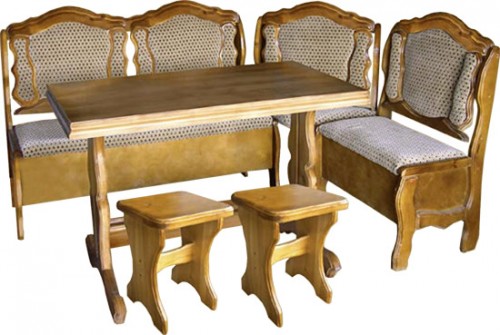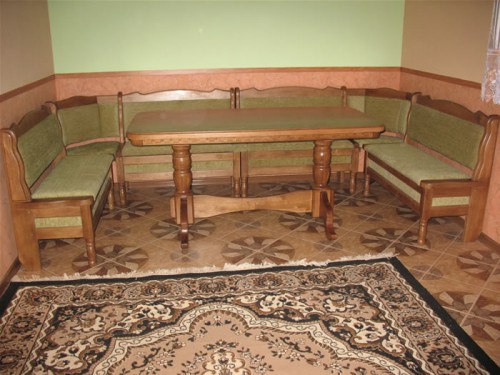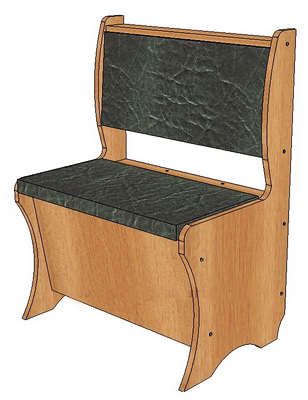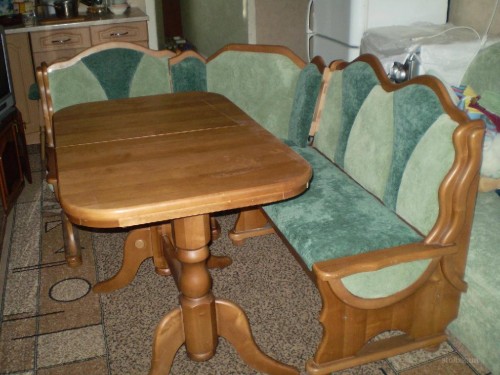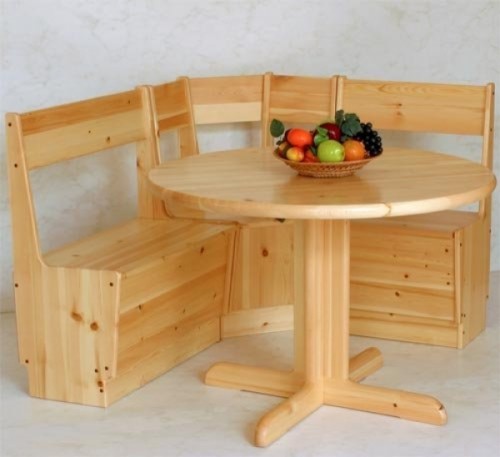The range of furniture stores has recently cannot but rejoice, however, for many consumers, there is still not enough exclusivity and originality of the proposed product.
Content
With particular scrupulousness, they are suitable for the acquisition of objects from the dining group, since the three main criteria - design, price and quality, do not always correspond to each other. It is precisely for those who do not like to choose between these criteria, there is a different option for leaving the situation, for example, make a kitchen corner with your own hands. This is the only way you will be absolutely confident that your project is unique, the only way you can experiment with the design and materials, the only way you will save. Despite the fact that the prices of kitchen corners are diverse, you can spend a little without any problems, but at the same time make a beautiful and exquisite thing.
Advantages of the kitchen corners
The kitchen corner, the photo of which can be seen below, as if created in order to gather the whole family or the company of closest friends at the table. That is why this interior item is attractive and always in demand. Due to the fact that the kitchen corners come in different designs, they can be accommodated in any, even the most tiny kitchen.
Basically, the kitchen corner consists of one or two sofas, two stools and one table. Despite such an impressive list of items, today you can purchase kitchen corners for a small kitchen - they will perfectly accommodate on the most modest kitchenette. Most often, there are twisted spacious niches in sofas, where you can store a variety of objects and utensils. Even the smallest kitchen corners can replace an additional cabinet in the kitchen. At the same time, you will save a place and start a nice sofa as an excellent and cozy place for a pleasant pastime.
Due to the lack of armrests and modern design, a kitchen sofa may well compete in elegance with a sofa from the living room.
If you decide to independently make a kitchen in the kitchen, then you need to look at the upholstery of the sofa. It is upholstery that can create an original and interesting idea - without it, furniture is not so attractive. Now, in great demand, soft upholstery, microfiber and artificial leather are in great demand.
It is also worth considering that if the kitchen table is made of natural wood, and not from chipboard and plastic, then it is best to make a kitchen corner made of wood.
Choose the type of kitchen corner
Corners for the kitchen are stationary and sliding.
- Stationary. Visually, this is a whole design, but its individual elements can be separated and rearranged, modifying the kitchen corner. The base on which the elements are attached can be unilateral, bilateral, direct, “Mr.”. Therefore, before proceeding with the layout and building a drawing of the kitchen corner, you need to determine which design you need.
- Sliding. Such sofas increase useful area, so they can be used as another sleeping place in the apartment, thanks to a retractable place. Basically, such furniture is equipped with a “dolphin” type with a mechanism.
It is much easier to build stationary corners - even one who does not have much experience in the “furniture business” will cope with them.
Choosing upholstery for the kitchen corner
Sitting on a wooden hard stool, of course, is not as pleasant as on a soft and comfortable chair. Currently, a wide variety of materials are used for upholstery of kitchen corners, among them:
- Artificial leather. The most popular material, of course, is leatherette, since it is not only practical and convenient, but also very economical and unpretentious. In addition, this is a real find for the kitchen, since this room is exposed to humidity daily, as well as various sources of pollution, and to leatherette, to everything else, is resistant to external irritants and scratches. Caring for such a upholstery is not at all complicated - it is enough to clean the sofa with any neutral detergent. At the same time, even after wet cleaning to the leatherette, it retains the original shape.
- Jacquard. Another practical option for upholstering the sofa into the kitchen, since synthetic fibers are remarkably let in air, repel water and dirt, practically do not electrize, do not cause allergies.
- Velours. This pile of this takny is moody both in care and in relation to a change in light. Velur can be “hardened” - these brilliant places have a completely unpresentable look.
- Flock. This material consists of nylon and cotton - they are held together by a special adhesive base. Thanks to a more durable pile, which is more thick and stronger, foc for upholstery is used much more often.
- Microfiber. Thanks to the microfibers of cotton or polyester, which have a villous surface, a bright microfiber is wear -resistant and easy to care.
Choose a filler for soft seats
In order for the seats to be elastic, but at the same time, soft and comfortable, you need to use a good filler. There are several types of groups:
- E (ST) - normal filler rigidity.
- EL - increased rigidity of the filler.
- HL - hard filler
- HR - high elasticity of the filler.
- ER is a soft filler.
When choosing a filler, remember that the softer it is, the more convenient it will sit. If you plan to use the corner as an additional sleeping place, then you need to put springs. This will make it more comfortable and more durable.
Production of a kitchen corner
The manufacture of the kitchen corner, the photo of which is given below, is not at all complicated, moreover, the price of it, if you count the cost of production, will seem to you just ridiculous compared to the one that can be seen in stores.
The sequence is visible on this drawing by which the kitchen corner is collected.
What will be needed
In order to build a kitchen corner with your hands, the following tools and materials are needed:
- Chipboard.
- Brick.
- Fat plywood.
- Foamen.
- Live fabric.
- Furniture glue.
- Hacksaw.
- Stapler and brackets.
- Self -tapping screws.
- Scurgery.
- Sponge tape.
Preparatory stage
- Before proceeding with the manufacture of the kitchen corner, you must carefully measure everything - the size of the kitchen and furniture must correspond.
- Build a drawing of the kitchen corner - it will be easier to transfer it to the materials from which it will be made.
- The basis of the sofa is a box along its entire length.
- The back wall of the sofa should be wider than all the others - it is support and back, convenience, strength and comfort depends on it.
- The front wall of the sofa is made with a scythe - down and inside, since this position will sit comfortably.
Production of a long sofa
The basis of the sofa
- Transfer the drawing from the drawing to the chipboard.
- Drink the details.
- Connect the details with self -tapping screws, and where necessary - bar.
- Play the sawn edges of the chipboard veneer - this will help to protect from moisture and give furniture aesthetic appearance.
Seat and back of the sofa
- Drink parts from thick plywood.
- Cut the part of the desired size from foam.
- Put the foam rubber on the plywood, tighten with an upholstery on top.
- Combine all the details using a stapler.
- Points 1-4 repeat for the back of the sofa.
Collection of the sofa
- Attach the sofa to the back with metal loops.
- To install a lifting mechanism if desired, but you can do without it.
- The seat can not be attached to the back - you can make it removable.
- Make sure that during installation all the details are tightly adjacent to each other.
- To make the back stronger, it can be strengthened by the beam.
- You can decorate the sofa with the help of self -sewn pillows, rollers, embroidery, etc.
Production of the connecting part
The technology for manufacturing a connecting corner is a little more complicated, but this does not mean at all that the process is not possible for a beginner.
- For the back, we select two stubborn strips from the chipboard of the corresponding size. These will be two details of the three necessary that will form the product.
- We combine the details with each other, using an electrician we cut out the strips that are used as supporting parts.
- In order for the corner to be able to stand more tightly near the wall, the connecting corner from the back must be cut off.
- Sitting has a trapezoidal shape. We process it in the same way as described above in the section "Production of a long sofa."
- Elements of the back should be clamped on the doughs between the sidewalls, and then additionally fixed with corners of metal to stubborn strips.
- The upholstery is carried out according to the same rules and principles described above.
- Fix a long sofa (or sofas) and the connecting part using self -tapping screws or using metal fasteners. The last option is more profitable, since it will be possible to change the angle to the right or left side.

